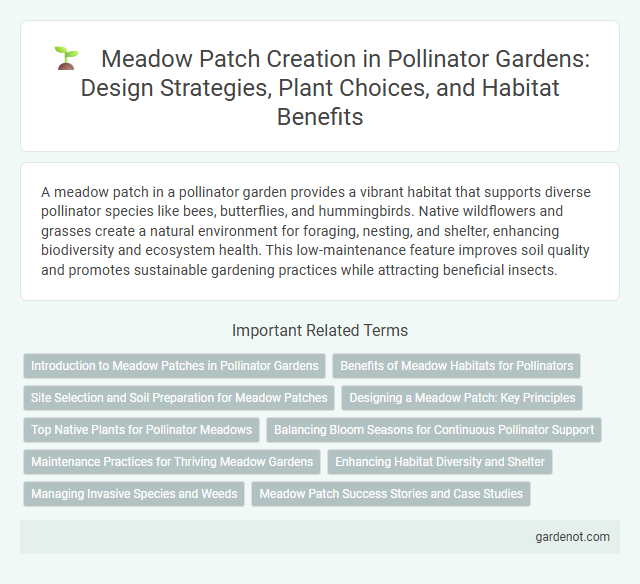A meadow patch in a pollinator garden provides a vibrant habitat that supports diverse pollinator species like bees, butterflies, and hummingbirds. Native wildflowers and grasses create a natural environment for foraging, nesting, and shelter, enhancing biodiversity and ecosystem health. This low-maintenance feature improves soil quality and promotes sustainable gardening practices while attracting beneficial insects.
Introduction to Meadow Patches in Pollinator Gardens
Meadow patches in pollinator gardens create essential habitats that support a diverse range of native pollinators, including bees, butterflies, and hummingbirds. These patches consist of a variety of native wildflowers and grasses that provide continuous nectar and pollen sources throughout the growing season. Establishing meadow patches enhances biodiversity, promotes ecological balance, and improves pollination services critical for both wild ecosystems and agricultural crops.
Benefits of Meadow Habitats for Pollinators
Meadow habitats provide diverse floral resources and continuous bloom periods essential for supporting a wide range of pollinators, including bees, butterflies, and hoverflies. These environments offer shelter, nesting sites, and a rich supply of nectar and pollen, enhancing pollinator health and biodiversity. Conserving meadow patches helps sustain pollination services critical for ecosystem stability and agricultural productivity.
Site Selection and Soil Preparation for Meadow Patches
Selecting a well-drained site with full sun exposure is crucial for establishing a thriving meadow patch within a pollinator garden. Soil preparation involves testing for pH levels between 6.0 and 7.0, followed by amending with organic compost to enhance fertility and structure. Removing existing vegetation and lightly tilling the soil ensures optimal seed-to-soil contact, promoting vigorous growth of native wildflowers and grasses favored by pollinators.
Designing a Meadow Patch: Key Principles
Designing a meadow patch involves selecting native wildflowers and grasses that support local pollinators such as bees, butterflies, and hummingbirds. Proper site preparation, including soil assessment and removing invasive species, ensures optimal plant growth and biodiversity. Incorporating diverse flowering times maximizes nectar availability across seasons, enhancing pollinator attraction and habitat sustainability.
Top Native Plants for Pollinator Meadows
Top native plants for pollinator meadows include Echinacea purpurea (purple coneflower), Asclepias tuberosa (butterfly weed), and Solidago canadensis (Canada goldenrod), which provide essential nectar and pollen sources. These species support diverse pollinators such as bees, butterflies, and hummingbirds by offering prolonged bloom periods and habitat structure. Incorporating a variety of native wildflowers and grasses enhances ecological stability and pollinator attraction in meadow patches.
Balancing Bloom Seasons for Continuous Pollinator Support
A well-designed meadow patch incorporates a diverse array of native wildflowers and grasses that bloom sequentially from early spring through late fall, ensuring continuous nectar and pollen sources for pollinators like bees, butterflies, and hummingbirds. Selecting species with overlapping bloom periods such as purple coneflower (Echinacea purpurea), black-eyed Susan (Rudbeckia hirta), and goldenrod (Solidago spp.) creates a dynamic floral timeline that supports various pollinator life stages. Maintaining soil health and avoiding pesticide use further enhances the meadow's role as a sustainable habitat promoting pollinator population stability year-round.
Maintenance Practices for Thriving Meadow Gardens
Regular mowing and selective weeding prevent invasive species from overpowering native wildflowers in a meadow patch, ensuring a vibrant pollinator habitat. Seasonal cutting at specific heights supports plant diversity and promotes robust root systems, enhancing soil health and water retention. Incorporating periodic soil testing guides nutrient management, optimizing growth conditions for a thriving, biodiverse meadow garden.
Enhancing Habitat Diversity and Shelter
A meadow patch within a pollinator garden significantly enhances habitat diversity by providing a variety of native wildflowers and grasses that support multiple pollinator species. The dense vegetation offers essential shelter and nesting sites for bees, butterflies, and other beneficial insects, promoting increased biodiversity. This natural habitat diversity strengthens ecosystem resilience and aids in sustaining healthy pollinator populations year-round.
Managing Invasive Species and Weeds
Effective management of invasive species and weeds in a pollinator garden's meadow patch involves regular monitoring and early removal to prevent competition with native plants. Utilizing manual removal techniques and targeted herbicides helps maintain plant diversity and supports pollinator habitat health. Maintaining a dense, diverse native plant cover also suppresses weed establishment and promotes ecosystem resilience.
Meadow Patch Success Stories and Case Studies
Meadow patch success stories highlight increased biodiversity and improved pollinator populations, with native wildflowers supporting bees, butterflies, and other beneficial insects. Case studies demonstrate that well-maintained meadow patches enhance ecosystem services, including pollination efficiency and soil health in urban and rural landscapes. Long-term monitoring reveals that diverse plant species compositions in meadow patches lead to more resilient pollinator habitats and sustained environmental benefits.
Meadow patch Infographic

 gardenot.com
gardenot.com